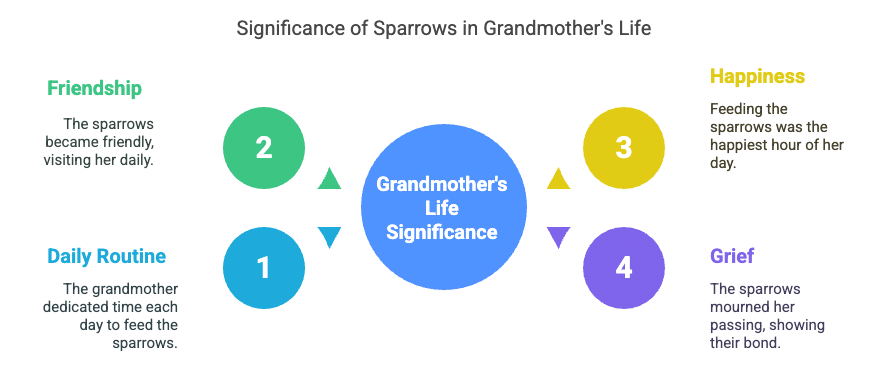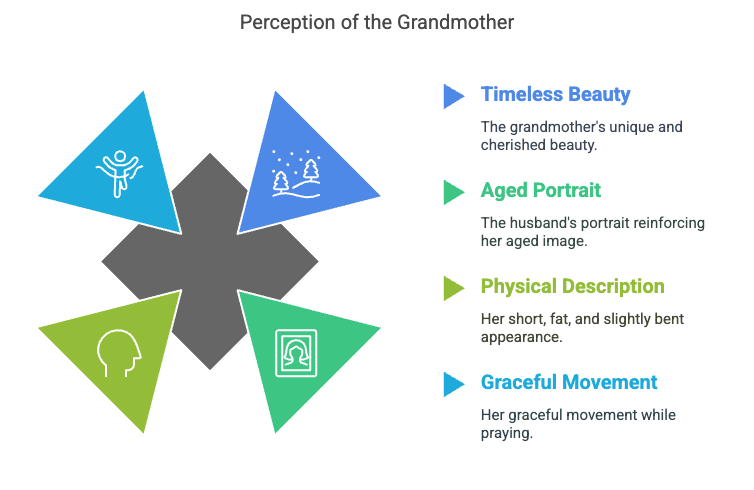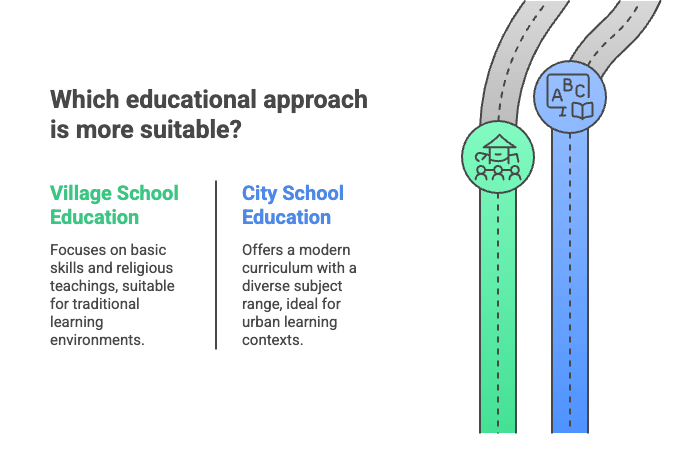Previous Year: Short Questions With Answers - The Portrait of a Lady | English Class 11 PDF Download
Q1. What is the significance of sparrows in grandmother's life?
Ans. When the grandmother moved to the city, she dedicated half an hour each day to feeding the sparrows. These birds became quite friendly with her, visiting her verandah daily. This routine was the happiest hour of her day. After her passing, hundreds of sparrows gathered in the verandah, sitting quietly near her body. They did not chirp or pay attention to the bread crumbs offered by the author's mother. This behaviour reflected their grief and the deep bond they shared with the grandmother.
 Q2. Give a pen picture of narrator’s grandfather as he appeared in the portrait?
Q2. Give a pen picture of narrator’s grandfather as he appeared in the portrait?
Ans. The narrator’s grandfather looked very old in the portrait. He had a long white beard that reached his chest, making him seem like he was from ancient times. His face was wrinkled, and he wore a turban, giving him the appearance of someone wise and serious. He looked as though he had many grandchildren and had lived a long life.
Q3. Did the narrator like his grandmother telling him of the games she played as a child? If not, why?
Ans. No, the narrator did not enjoy his grandmother's stories. He found the games she described to be childish and funny. It was difficult for him to take them seriously because he had always seen her as an old woman, making it hard to imagine her playing games as a child.
Q4. Why did the grandmother keep one hand on her waist?
Ans. The grandmother was very old and had a slight bend in her back. To help balance herself and stay steady while walking, she kept one hand on her waist.
Q5. Explain. “As for my grandmother being young and pretty, the thought was almost revolting?”
Ans. The narrator's grandmother always appeared old, with wrinkles covering her face for the entire twenty years they knew her. Though others claimed she was once young and pretty, this seemed unbelievable, especially with her husband's aged portrait reinforcing the idea. Short, fat, and slightly bent, she exuded a unique beauty—serene and timeless, like a winter landscape. Dressed in white, she moved gracefully, counting her rosary beads, her silver hair framing her wrinkled face as she prayed silently. This image of her remained deeply cherished by the narrator.
 Q6. Why did the grandmother hate music?
Q6. Why did the grandmother hate music?
Ans. The grandmother didn’t like music because she believed it was only meant for beggars and people of low status. She thought music wasn’t suitable for children from good, respectable families.
Q7. The narrator’s grandmother looked like ‘the winter landscape in the mountains’. Comment.
Ans. The narrator compares his grandmother to the winter landscape because she always wore white clothes and had white hair. This appearance made her seem calm, peaceful, and pure, resembling the snowy mountains in winter.
Q8 . The grandmother had a divine beauty. How does the author bring it out?
Ans. The grandmother had silvery locks scattered untidily over her pale and wrinkled face, giving her an appearance of pure white serenity. This unique look contributed to her divine beauty, reminiscent of a winter landscape in the mountains, embodying an expanse of peace and contentment.
Q9. How were the grandmother and the narrator good and intimate friends?
Ans. The grandmother and the narrator shared a deep and intimate bond. She would wake him up early in the morning, help him get ready for school, and prepare his breakfast of stale bread with butter and sugar. She also accompanied him to school, strengthening their companionship through daily routines and care.
Q10. Why did the grandmother accompany the narrator to his school? What did she do there?
Ans. The grandmother accompanied her grandson to school, which was located next to a temple. While he studied, she sat inside the temple, reading scriptures. After school, they walked home together, often greeted by the village dogs that followed them, hoping for the chapattis they would toss to them.
Q11. What did the priest teach at the village school?
Ans. The priest taught the alphabet and the morning prayer at the village school. He arranged the students to stand in rows on either side, where they would sing the alphabet and the morning prayer together in a chorus.
Q12. Describe the feeding of village dogs by the grandmother.
Ans. As the narrator and his grandmother walked home from school, the village dogs would greet them at the temple door. The grandmother would throw chapattis for the dogs, who would growl and fight over the crumbs. This routine highlighted the bond they shared with the dogs during their walks.
Q13. What was the turning point in their friendship?
Ans. The narrator’s parents brought them to the city. It was the turning point in their friendship. The city life and English school made all the difference. She didn’t accompany him to his school. Nor could she help him in his studies. They saw less of each other now.
Q14. What opinion did the grandmother form of the English school in the city?
Ans. The grandmother had a negative opinion of the English school in the city. She felt sad because the school did not teach about God or the scriptures, which were important to her. Additionally, she was not interested in Science and disliked the music lessons offered there.
Q15. How was the common link of friendship between the grandmother and the grandson snapped?
Ans. When the narrator’s family shifted to the city, the grandmother couldn’t accompany him to the school as she used to do in the village. Now he would go by motor bus. She was not able to help the grandson in his studies also. Thus the common link between their friendship snapped.
Q16. Draw a comparison between village school education and city school education.
Ans. In a village school, children learned basic skills such as the alphabet, simple mathematics, and prayers. The education was traditional and heavily focused on religion. In contrast, a city school offered a more modern curriculum, including subjects like English, Science, and Music, with little emphasis on religious teachings. This shift reflects the differences in educational approaches between rural and urban settings.
 Q17. What were the happiest moments of the day for the grandmother?
Q17. What were the happiest moments of the day for the grandmother?
Ans. The happiest moments for the grandmother were when she fed the sparrows in the verandah. Hundreds of sparrows would come and sit on her, and she loved being surrounded by them. It gave her peace and joy, and she looked forward to this time every day.
Q18. How did the grandmother react when the narrator decided to go abroad ? Was she upset?
Ans. The grandmother appeared to be quite normal. She knew that her grandson would be away for five years. She looked composed and didn’t show any emotion. She came to see him off at the station. She kissed him lightly on his forehead before departing.
Q19. Why did the narrator think that the grandmother’s kiss was the last sign of physical contact between them?
Ans. The narrator cherished the moist imprint of his grandmother's kiss on his forehead as he left for abroad, believing it to be the last sign of physical contact between them. He did not expect her to live for another five years, the duration of his absence. This thought made the kiss particularly significant for him.
Q20. How did the grandmother celebrate the home coming of his grandson?
Ans. The grandmother was overjoyed when the narrator returned from abroad. To celebrate his arrival, she gathered the women from the neighbourhood in the evening. She played an old drum and sang for hours, forgetting to pray for the first time. Her excitement was evident as she thumped the drum and sang about the homecoming of warriors.
Q21. Why did the grandmother stop talking to anybody before her death?
Ans. When the grandmother fell ill with a mild fever, the doctor reassured the family of her recovery. However, she believed her end was near. Feeling she had neglected her prayers the previous evening, she chose to spend her remaining time in devotion. Ignoring all protests, she lay in bed, praying and counting her beads in silence.
Q22. Why didn’t the sparrows take any notice of the bread crumbs thrown to them. How would you explain their strange behaviour at the death of the grandmother?
Ans. The sparrows expressed their grief at the death of the grandmother. They sat around her dead body mourning her death. They didn’t chirp. Nor did they touch the bread crumbs thrown to them by the narrator’s mother. They flew away quietly when the dead body was carried off.
Q23. What stories of the grandmother did the author treat as ‘Fables’ of the Prophets? Why?
Ans. The author regarded the stories of his grandmother's youth and beauty as fables because he had only known her as an old woman. It was difficult for him to accept that she could have once been pretty and young. Her appearance was a stark contrast to the vibrant tales she shared, making it hard for him to reconcile the two images.
Q24. What does Khushwant Singh describe in ‘The Portrait of a Lady’?
Ans. In The Portrait of a Lady, Khushwant Singh paints a vivid picture of his grandmother. He shares memories of their time together during his childhood in the village and highlights the changes in their relationship when they moved to the city. The narrative reflects both their bond and the impact of urban life on their connection.
Q25. Grandmother never complained about anything. Her patience was beyond any measure. Mention any two instances.
Ans. Two instances that demonstrate the grandmother's patience are: When she fed the sparrows, they would often sit on her head, yet she never shooed them away. Additionally, when the author decided to go abroad for higher education, she accepted this decision with a calm and composed attitude, showing no signs of distress
|
73 videos|588 docs|80 tests
|
FAQs on Previous Year: Short Questions With Answers - The Portrait of a Lady - English Class 11
| 1. Who is the main character in "The Portrait of a Lady"? |  |
| 2. What themes are explored in "The Portrait of a Lady"? |  |
| 3. How does the author portray the relationship between the narrator and his grandmother? |  |
| 4. What role does the setting play in "The Portrait of a Lady"? |  |
| 5. What is the significance of the grandmother's death in the story? |  |

















